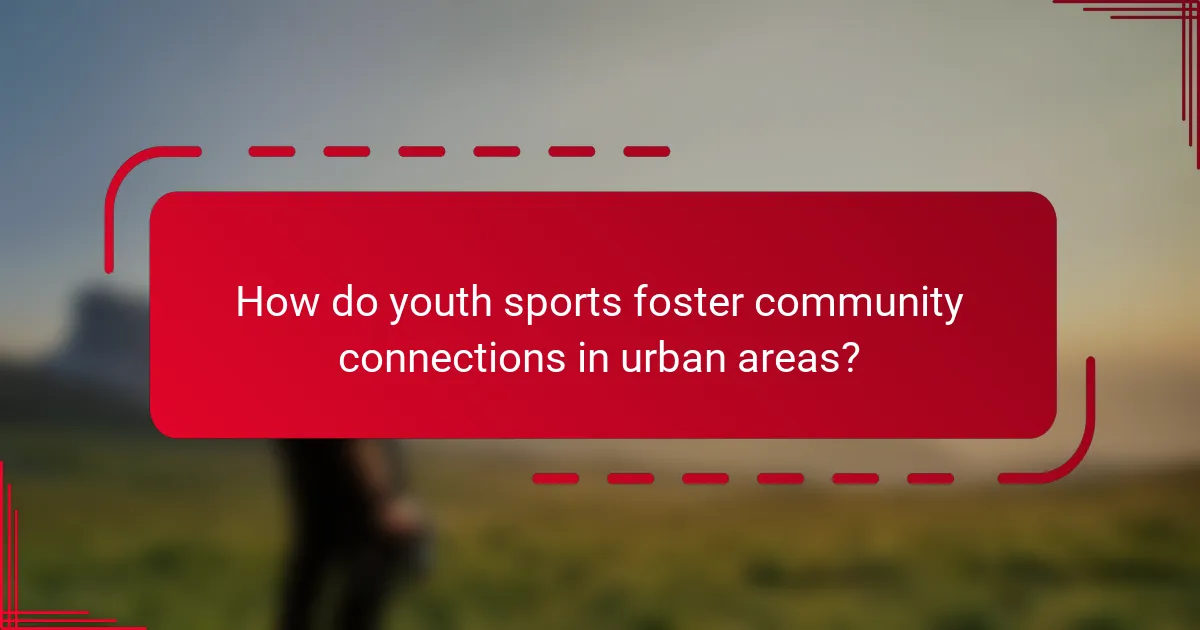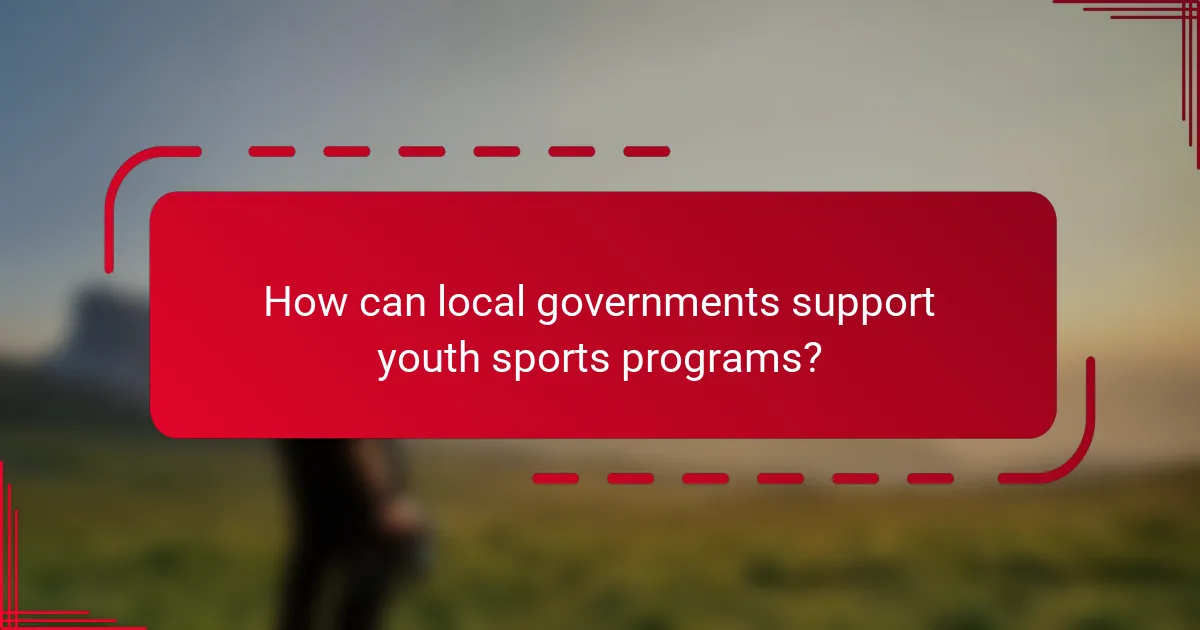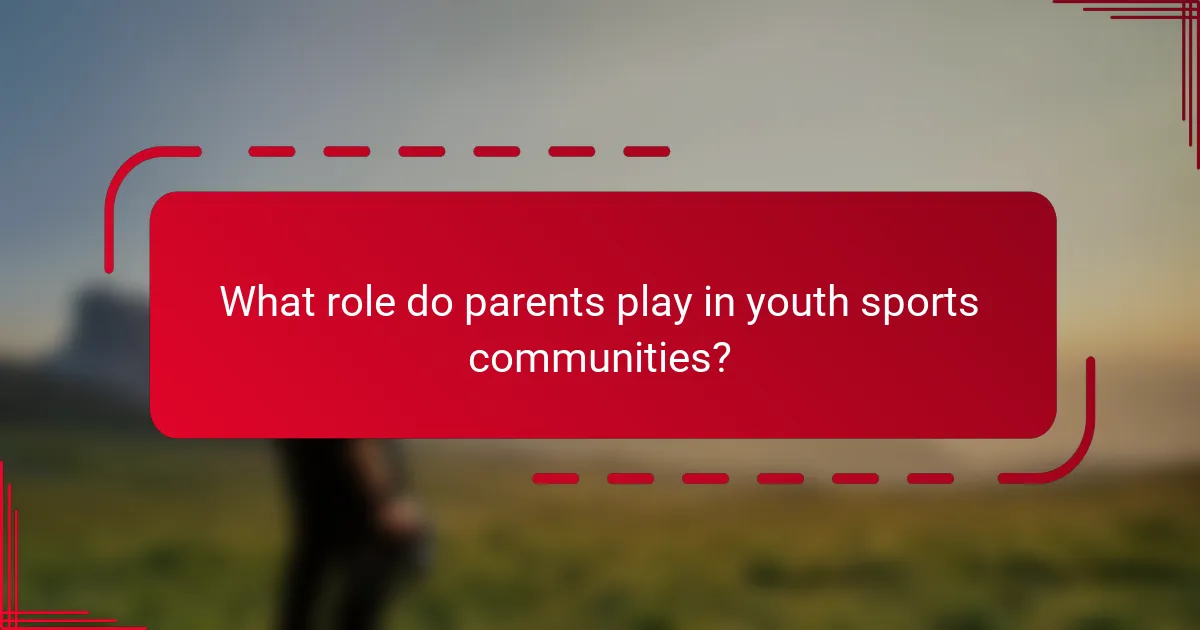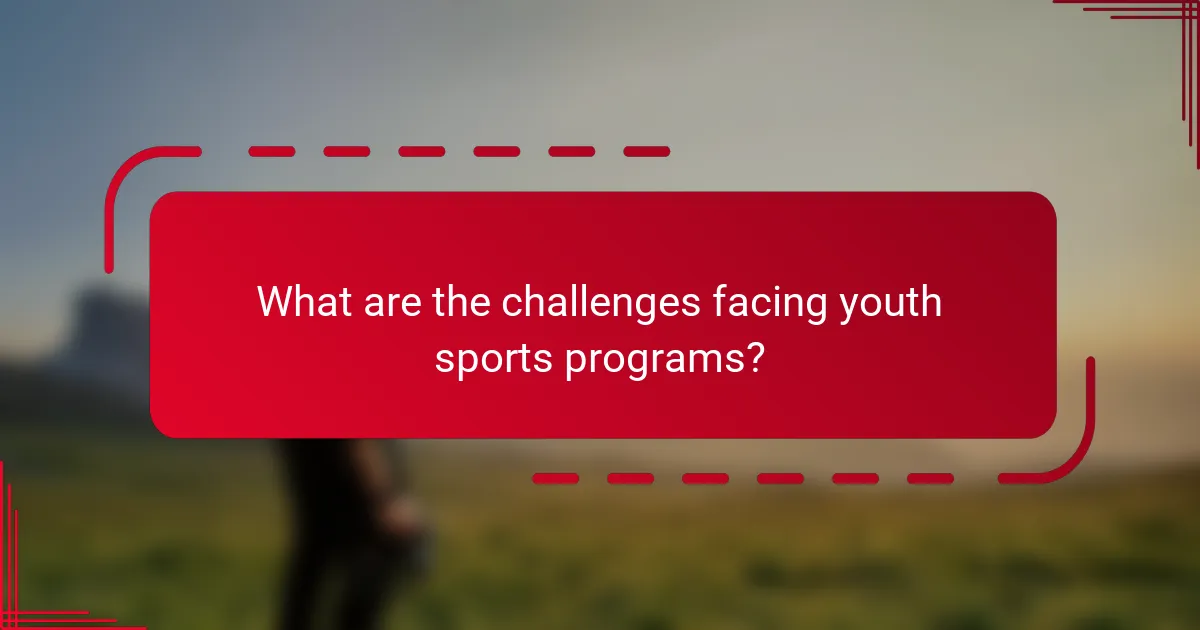Youth sports serve as a cornerstone for building community connections, uniting families, local organizations, and residents in urban areas. These programs not only foster a sense of belonging but also enhance social networks, promoting collaboration and engagement within the community.

How do youth sports foster community connections in urban areas?
Youth sports play a vital role in fostering community connections in urban areas by bringing together families, local organizations, and residents. These activities create a sense of belonging and enhance social networks, which are essential for community cohesion.
Increased social interaction
Youth sports encourage increased social interaction among participants, parents, and coaches. Regular practices and games provide opportunities for families to meet and engage with one another, fostering friendships and support networks.
Additionally, these interactions often extend beyond the sports field, leading to collaborations in other community activities such as volunteering or local events. This creates a more interconnected urban environment.
Shared community events
Shared community events, such as tournaments and fundraisers, are common in youth sports and serve to unite diverse groups. These events often attract participants from various backgrounds, promoting inclusivity and teamwork.
For instance, a local soccer tournament may involve teams from different neighborhoods, encouraging residents to come together, celebrate their youth, and strengthen community ties. Such events can also raise funds for local charities, further enhancing community spirit.
Local business support
Youth sports often receive support from local businesses, which can enhance community connections. Sponsorships from nearby shops and services not only provide financial backing but also promote local commerce.
For example, a local pizza shop might sponsor a youth baseball team, leading to increased visibility and customer loyalty. This symbiotic relationship benefits both the sports teams and the businesses, creating a thriving local economy.

What are the benefits of youth sports for community engagement?
Youth sports play a crucial role in fostering community engagement by bringing together families, local organizations, and residents. These activities create opportunities for social interaction, collaboration, and the development of strong community ties.
Building trust among residents
Youth sports can significantly enhance trust among community members by providing a shared space for interaction. When families and individuals come together to support local teams, they build relationships that transcend social barriers.
Regular participation in youth sports events fosters a sense of belonging, encouraging residents to connect with one another. This trust can lead to increased cooperation in other community initiatives, strengthening the overall fabric of the neighborhood.
Encouraging volunteerism
Engagement in youth sports often inspires residents to volunteer their time and skills. Parents, coaches, and community members frequently step up to help organize events, manage teams, or provide support during games.
This volunteerism not only enhances the sports programs but also cultivates a culture of giving back. Communities that actively support youth sports tend to see higher rates of volunteer participation in other local projects, creating a cycle of engagement.
Promoting inclusivity
Youth sports can serve as a platform for inclusivity, welcoming children from diverse backgrounds to participate. Programs that prioritize inclusivity help ensure that all children, regardless of their abilities or socio-economic status, have the opportunity to engage in sports.
By fostering an environment where every child feels valued, communities can break down barriers and promote understanding among different groups. This inclusivity not only enriches the sports experience but also strengthens community bonds, making neighborhoods more cohesive and supportive.

How can local governments support youth sports programs?
Local governments can support youth sports programs through funding, facility improvements, and partnerships with schools. By investing in these areas, they can enhance community engagement and provide essential resources for young athletes.
Funding and grants
Funding and grants are crucial for the sustainability of youth sports programs. Local governments can allocate budgetary resources or seek state and federal grants to support these initiatives. This financial backing can cover equipment, uniforms, and coaching expenses, ensuring that programs remain accessible to all children.
Additionally, governments can create grant programs specifically for youth sports organizations. These grants can help offset costs and encourage community involvement, leading to more robust participation rates.
Facility improvements
Improving sports facilities is essential for fostering youth sports participation. Local governments can invest in upgrading existing fields, courts, and gyms to meet safety standards and enhance usability. This might include installing better lighting, resurfacing courts, or adding bleachers for spectators.
Moreover, creating new multi-sport complexes can provide diverse options for youth sports. These facilities can serve as community hubs, hosting tournaments and events that bring families together and strengthen local ties.
Partnerships with schools
Forming partnerships with local schools can significantly enhance youth sports programs. Schools often have facilities and resources that can be shared with community sports organizations. By collaborating, both entities can create a more comprehensive sports curriculum that benefits students and local athletes alike.
Local governments can facilitate these partnerships by organizing meetings between school administrators and sports organizations. Establishing clear agreements on facility use and scheduling can maximize resource efficiency and ensure that all youth have access to quality sports programs.

What role do parents play in youth sports communities?
Parents are crucial in youth sports communities as they provide support, resources, and leadership. Their involvement enhances the experience for young athletes and fosters a sense of belonging among families.
Volunteer coaching
Many parents take on the role of volunteer coaches, which is vital for the development of youth sports programs. This involvement not only helps to fill coaching gaps but also allows parents to directly influence their children’s sports experience. Training sessions and games become opportunities for parents to bond with their kids while teaching essential skills.
To be effective, volunteer coaches should familiarize themselves with the sport’s rules and best practices. They can attend coaching clinics or seek resources online to enhance their coaching techniques. This preparation can lead to a more positive environment for young athletes.
Organizing events
Parents often play a key role in organizing events such as tournaments, fundraisers, and team-building activities. These events are essential for building community spirit and raising funds for equipment or travel expenses. A well-organized event can strengthen relationships among families and create lasting memories for young athletes.
When planning events, parents should consider logistics like venue selection, scheduling, and volunteer assignments. Clear communication and delegation of tasks can ensure that events run smoothly and are enjoyable for everyone involved.
Creating a support network
Parents contribute to creating a support network that benefits both athletes and families. This network can provide emotional support, share resources, and facilitate connections among families. A strong support system can help families navigate challenges, such as balancing sports with academics or managing travel commitments.
To foster this network, parents can establish communication channels, such as group chats or social media pages, to share updates and coordinate activities. Regular meetings or informal gatherings can also strengthen these connections and enhance the overall community experience.

How do youth sports impact local economies?
Youth sports significantly boost local economies by increasing spending, creating jobs, and attracting events. These activities generate revenue for businesses and provide employment opportunities, ultimately enhancing community vitality.
Increased spending at local businesses
Youth sports programs lead to increased spending at local businesses, such as restaurants, retail stores, and service providers. Families often spend money on meals, gear, and other necessities when attending games or practices.
This spending can contribute to a vibrant local economy, with estimates suggesting that a single tournament can generate thousands of dollars in revenue for nearby establishments. Communities can capitalize on this by promoting local businesses during sporting events.
Job creation in coaching and administration
The growth of youth sports programs creates job opportunities in coaching, administration, and support roles. Local organizations often hire coaches, trainers, and administrative staff to manage teams and events.
These positions not only provide income but also foster community engagement, as coaches and staff often become role models and mentors for young athletes. Investing in training and development for these roles can enhance the quality of youth sports programs.
Attracting regional tournaments
Youth sports can attract regional tournaments, which bring in participants and spectators from outside the local area. Hosting these events can significantly boost local tourism and hospitality sectors.
Communities should invest in facilities and infrastructure to accommodate larger events, as well as promote their venues to sports organizations. Successful tournaments can lead to repeat business and establish a community as a go-to destination for youth sports competitions.

What are the challenges facing youth sports programs?
Youth sports programs encounter several challenges that can hinder their effectiveness and sustainability. Key issues include funding limitations, access to facilities, and the need for qualified coaches. Addressing these challenges is crucial for fostering a supportive environment for young athletes.
Funding and Resources
Many youth sports programs struggle with securing adequate funding and resources. This can lead to limited equipment, insufficient facilities, and reduced opportunities for participation. Programs often rely on local sponsorships, fundraising events, and community donations to bridge the financial gap.
To improve funding, organizations should consider creating partnerships with local businesses and exploring grant opportunities. Establishing a clear budget and demonstrating the program’s impact can also attract potential sponsors.
Access to Facilities
Access to suitable facilities is a significant challenge for youth sports programs. Many communities lack adequate fields, courts, or gyms, which can restrict practice times and game schedules. This can result in overcrowding and limited access for participants.
To mitigate this issue, programs can collaborate with schools, parks, and recreation departments to share facilities. Scheduling practices during off-peak hours can also help maximize usage and ensure that all teams have adequate access.
Qualified Coaches and Volunteers
Finding qualified coaches and volunteers is essential for the success of youth sports programs. Many programs face difficulties in recruiting individuals with the necessary skills and training to effectively mentor young athletes. This can impact the quality of instruction and the overall experience for participants.
To attract and retain qualified coaches, programs should offer training opportunities and incentives, such as stipends or certifications. Engaging parents and community members in volunteer roles can also help build a supportive coaching staff.
